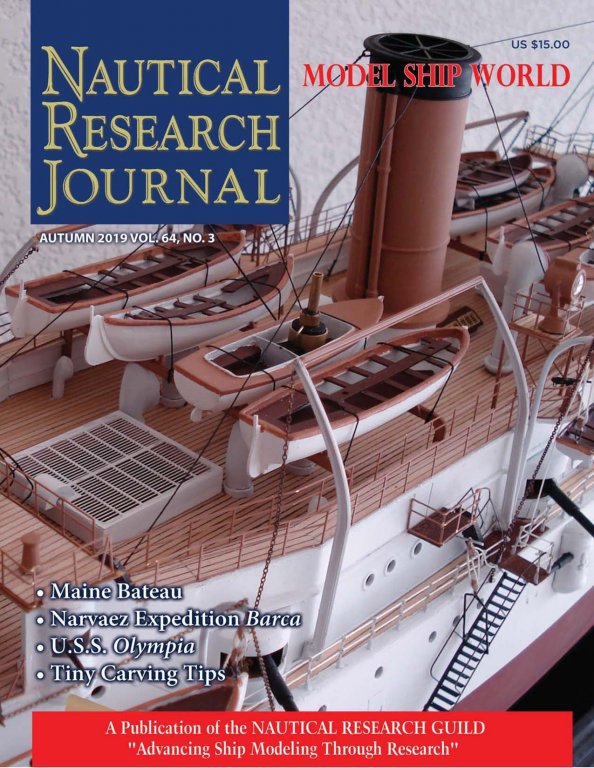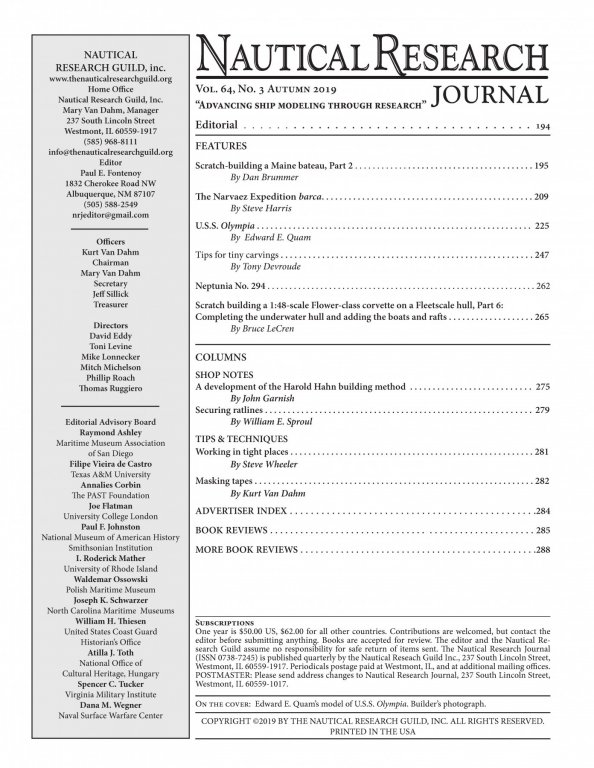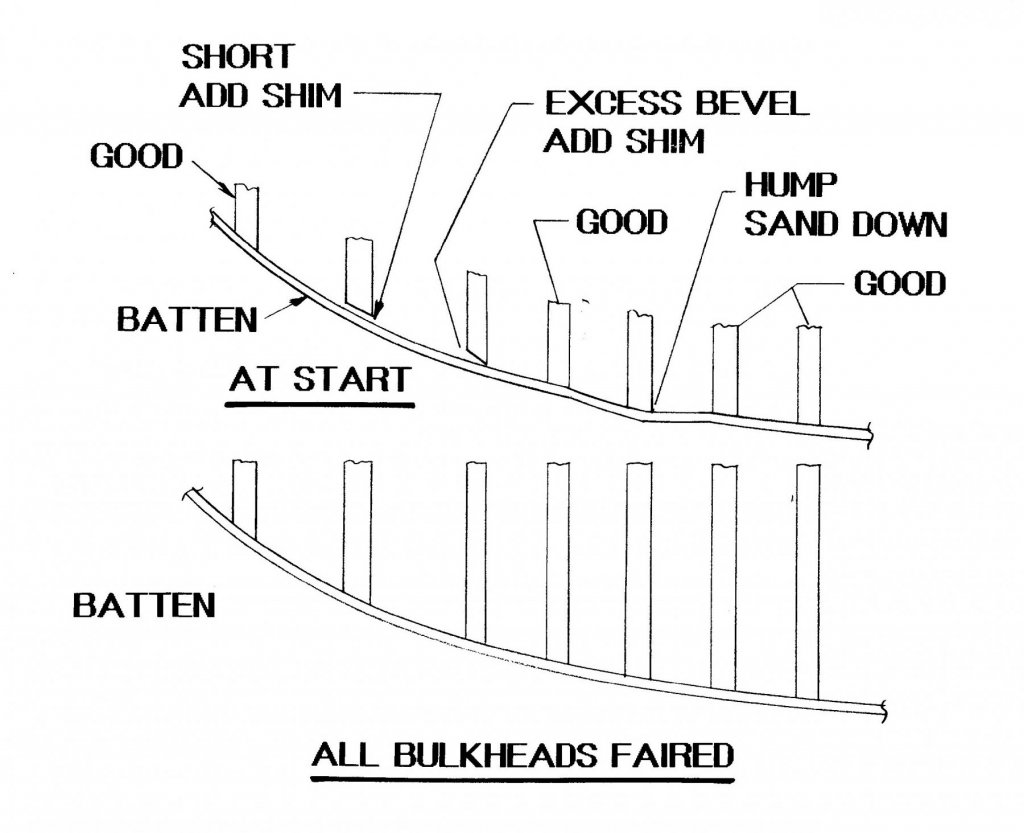-
Posts
3,032 -
Joined
-
Last visited
Content Type
Profiles
Forums
Gallery
Events
Everything posted by kurtvd19
-
They are a MSW sponsor and would not be allowed to be a sponsor if they sold pirated kits. Kurt
-
Yeah, I realized that later. But when you do I know you will be incorporating the extras I didn't included.😀
- 23 replies
-
- model shipways
- chaperon
-
(and 1 more)
Tagged with:
-
Russ: Glad to see another Chaperon on the building ways. I am almost tempted to build another and do some of the things that I didn't have time to do before (and meet the magazine deadlines). Eric and others have added the details and I hope you follow suit. Have fun... Kurt
- 23 replies
-
- model shipways
- chaperon
-
(and 1 more)
Tagged with:
-
Chris: Nerve pain can be real bad and the drugs are absolutely necessary. Please double check all your work once you are off of them as errors can creep in (ask me how I know...) - we don't want your kit to be mistaken for the typical kits that I swear were designed by people on some very serious drugs...🤐 Hope you feel better soon. Kurt
-

Changing the blade on a Byrnes Saw
kurtvd19 replied to fnkershner's topic in Modeling tools and Workshop Equipment
There is an opening on the front end of the belt guard. There are flats on the shaft for a 3/8-inch open end wrench to hold the shaft from turning. Kurt -
Bruce: I meant to include this drawing inmy previous reply. It was made to illustrate a single planked hull and how to check for fairness and the need to possibly shim some areas or sand others to get a fair run of the planks. But it shows how the planks can run straight between bulkheads. The kit this drawing was referring to had plenty of bulkheads for single planking - a rare kit - but the idea works to illustrate my point from earlier. Good luck on your build and please do a build log. Kurt
-
Double planking is done to provide a fair base for the final planking - usually because the bulkheads are widely spaced and the planks stretching between the bulkheads tend to flatten out rather than keeping the fair curve that closely spaced bulkheads would provide. The area that are not fair can be sanded down or filler added as needed to provide the fair surface. Same as planking a solid carved hull. If your bulkheads are close together double planking isn't needed. Kurt
-
Mike: I hope you have better luck at it than I have had. I had to work the NRG registration table and be at the hotel for the vendor and model room set up during the NRG Conference day there. So Sunday, with the conference over was going to be my day to tour the museum. A half hour before it opened it started to rain so hard walking around there was out of the question - so I got home earlier than planned. I attended the 2018 annual Joint Clubs meeting of the east coast clubs that is held the last Saturday in April in New London. Almost next door. Got to CT on Friday about noon to see Mystic before the Saturday meeting - and it rained the whole day. Got to walk around a couple of the buildings close to the entrance but there was no way to see the rest of the place. So, two trips with very little actually seen. I hope you have better luck - or have a full set of rain gear along. Kurt
-
The entire collection of Ships in Scale (except for 2011-2018 - coming soon) is available from the NRG store as Jaeger said. NRG members get a 20% discount from the prices shown. If you just want the one article contact the NRG office - see the web site for phone - ask Mary to have me make you a copy. We have many of the Journal articles available singly and some day will have them all and I do up ones that we don't have upon request - so I can do it for this article from SiS. The charge is $2.50 by pay pal and it is emailed as a PDF. Kurt
-
Mike: Sorry but I can't give any specific recommendations on the paints mentioned as I have not used them - except the Tamiya spray cans. However, as you want to use acrylics and will be using an airbrush I think it is best to stick with the bottles of one brand. Please order adequate paint so you can practice with the airbrush before applying paint to your model. The model is not the piece to practice on. It is best to practice on the same material as the model, so if nothing else practice on painting the sprues or pick up a sacrificial simple plastic kit of some sort as a practice piece. Kurt
-

A new angle in precision sanding
kurtvd19 replied to Arcticbeaver's topic in Modeling tools and Workshop Equipment
I have the Dremel disc/belt combo - kicks up a dust storm - relegated to the wood shop where the dust doesn't matter. Got the Byrnes disc sander - it captures 99.9% of the dust, and is a world apart from the Dremel unit. I was impressed that the Byrnes unit keeps spinning for darn near a full minute after killing the power - that's a matter of mass and great balance. The disc runs true with no movement along the axis - the Dremel quits spinning in about 3 seconds and there is very noticeable movement along the axis. The Dremel disc will never be used on a model again - the belt is OK for non-model use but when the last belt I have is worn out the garbage guy can have the unit. All that said I personally think it's a better unit than the one that started this thread. Kurt -
Mike: I soak the photo etch in Lacquer thinner to remove any residual chemicals from the etching process - then rinse in water and air dry. As to thinning paint - some are ready for airbrushing and need no thinning and adding thinner would be detrimental to the coverage. If you need to thin paints for airbrushing use the mfg's recommended thinner. Usually the airbrush ready paints do not brush as well as the one that need thinning for airbrushing - just plan on multiple coats with the airbrush ready paints. Kurt
-

Optivisor Recommendations?
kurtvd19 replied to Landlubber Mike's topic in Modeling tools and Workshop Equipment
Mike: The Optivisor by Donagan Optical Co. with GLASS lenses is the one to get. The lenses come in different magnifications. Go to the Donagan web site to see all the different lenses available and then you can search Amazon for the best price. Stay away from the plastic lenses - I gave my plastic lens unit away after trying a set with glass lenses at a trade show - even before the new set arrived. They have a magnifying Opti-loupe that can be put on either side and I recommend you get one. I have the DA-5 and the DA-10 lenses - the 10's are for very close work. The Opti-loupe lets you get higher magnification w/o having to switch out the lens plate. I Highly recommend this untit. https://doneganoptical.com/product/optivisor/ Kurt -
They are sometimes called back boards - I am sure there is a technical term For authenticity the light back boards should conform to the standards with the vertical surfaces on the light's side of the assembly normally painted red and green as applicable to offer better visibility. The other surfaces can be whatever the other colors nearby are (in your case black is fine) except the red and green can not show except on the surfaces lit by the lights. Kurt
-
I use acrylics 90+% of the time - I have a spray booth for the smaller stuff but have not felt the need for a big booth as the over spray is completely dry before it lands on anything beyond the model. A bit of cleanup with a vacuum cleaner and no problem. If spraying over a finished floor use a cheap plastic drop cloth (picnic type table covers are good) and when you are done take it outside and shake it clean. It's good enough for when we demo in a hotel ballroom at trade shows. But ONLY for acrylics - solvent based must use safe extraction. Kurt
-
Roger: You know I would love to have one in Duluth and so would Steve Wheeler. The three of us would probably be pretty lonely though. Kurt
- 599 replies
-
- sidewheeler
- arabia
-
(and 4 more)
Tagged with:
-
Thanks for the additional information Eric. Very interesting. Knew they will have to move the Arabia Museum but had no idea of the ideas for Jeff City.
- 599 replies
-
- sidewheeler
- arabia
-
(and 4 more)
Tagged with:
-
Dave Hawley found another MO River wreck buried in a farmers field.. https://www.kcur.org/post/second-sunken-steamboat-raises-questions-kansas-citys-arabia-museum?fbclid=IwAR0yYp5zui1_dmw1_hbdTD4rK9O9hU1K-tyBrDScfn_n3asXpF_KBbnNglU#stream/0
- 599 replies
-
- sidewheeler
- arabia
-
(and 4 more)
Tagged with:
About us
Modelshipworld - Advancing Ship Modeling through Research
SSL Secured
Your security is important for us so this Website is SSL-Secured
NRG Mailing Address
Nautical Research Guild
237 South Lincoln Street
Westmont IL, 60559-1917
Model Ship World ® and the MSW logo are Registered Trademarks, and belong to the Nautical Research Guild (United States Patent and Trademark Office: No. 6,929,264 & No. 6,929,274, registered Dec. 20, 2022)
Helpful Links
About the NRG
If you enjoy building ship models that are historically accurate as well as beautiful, then The Nautical Research Guild (NRG) is just right for you.
The Guild is a non-profit educational organization whose mission is to “Advance Ship Modeling Through Research”. We provide support to our members in their efforts to raise the quality of their model ships.
The Nautical Research Guild has published our world-renowned quarterly magazine, The Nautical Research Journal, since 1955. The pages of the Journal are full of articles by accomplished ship modelers who show you how they create those exquisite details on their models, and by maritime historians who show you the correct details to build. The Journal is available in both print and digital editions. Go to the NRG web site (www.thenrg.org) to download a complimentary digital copy of the Journal. The NRG also publishes plan sets, books and compilations of back issues of the Journal and the former Ships in Scale and Model Ship Builder magazines.






